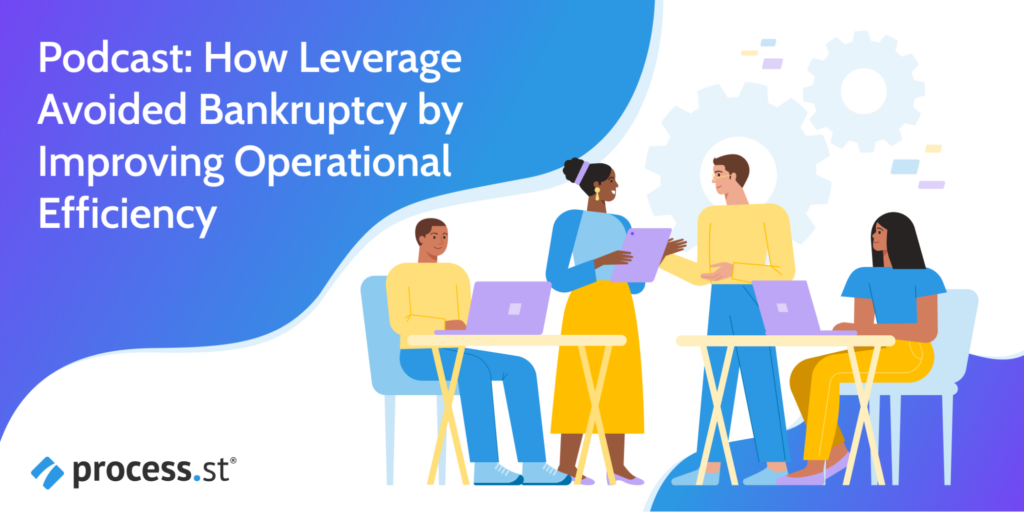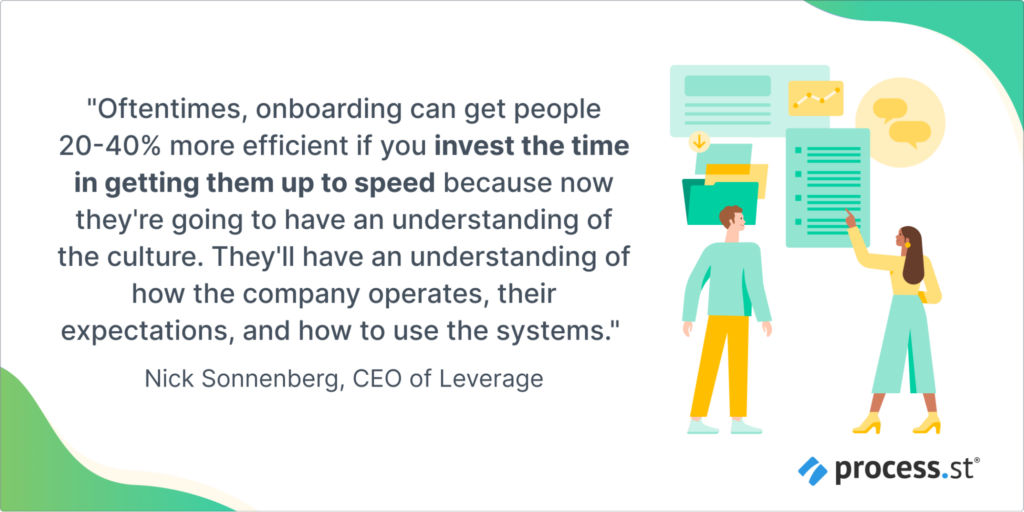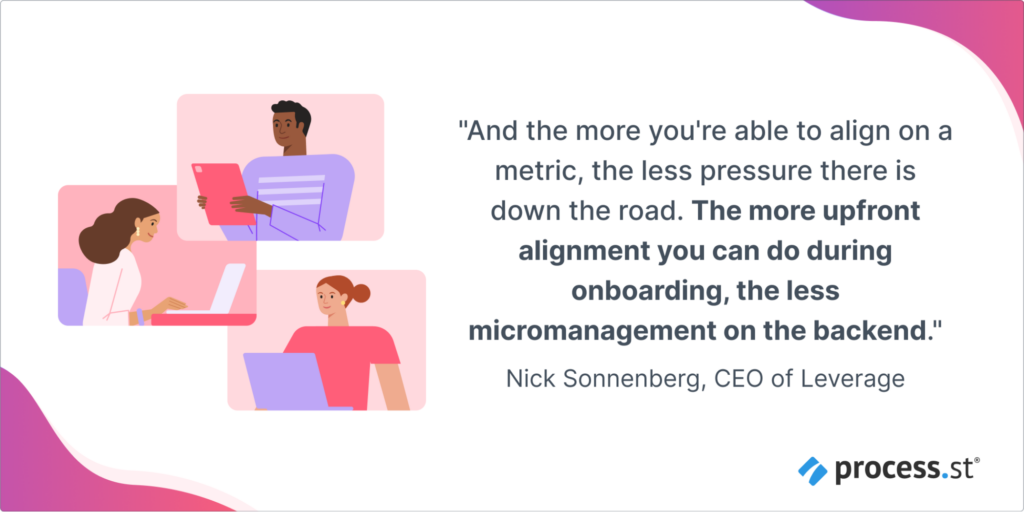
Nick Sonnenberg is an entrepreneur, columnist, guest lecturer at Columbia University, and the Wall Street Journal’s bestselling author of Come Up for Air: How Teams Can Leverage Systems and Tools to Stop Drowning in Work.
Nick is also the founder and CEO of Leverage, a leading operational efficiency consultancy that helps companies implement the CPR business efficiency framework.
It’s the culmination of Nick’s unique perspective on the value of time, efficiency, and automation, which stems partly from the eight years he spent working as a high-efficiency trader on Wall Street.
In this episode of The Employee Onboarding Podcast from Process Street, Nick discusses:
- How operational efficiency saved Leverage from bankruptcy
- The key to successful onboarding
- Creating a “wow” moment for new hires
- Come Up for Air
You can listen on Apple, Spotify, Google, Podchaser, Podcast Addict, Deezer, & all your favorite podcast platforms!
How operational efficiency saved Leverage from bankruptcy
I’d love if you could start by sharing a little bit more of how you ended up starting your business, Leverage.
Nick Sonnenberg
Sure. So as you mentioned, I used to be a high-frequency trader on Wall Street for eight years. So I was developing algorithms and coding computers to trade stocks at literally micro and nanosecond speeds, purely just based on math. And I developed a really deep appreciation for automation and the value of time, because in that space, literally a microsecond could mean millions and millions of dollars.
So after that, I got into startups and the initial version of Leverage was this freelancer marketplace. So I’ve always been passionate about figuring out some way to save time. And so the initial [question] was, how can we just get freelancers to do stuff for you to save entrepreneurs’ and business owners’ time? And we scaled really quickly. We scaled to–I had a business partner at the time–and together, we scaled to like seven figures in the first year and a hundred and fifty people on the team.
Which sounds impressive, but under the hood, we were a complete mess. The Org Chart was literally just the two of us. He was people-facing and I was the non-people-facing person. So I was like the wizard behind the curtains developing strategy and automation and various things. And also, we were like three-quarters of a million dollars in debt and losing half a million a year. So we grew really fast, but we had a lot of issues under the hood.
And one day we were working at a coffee shop together. And I’m sitting there holding my coffee and he comes up and taps me on the shoulder and he drops the news that he’s out. Not in two weeks or two days, literally he’s out in two minutes. And so I’m holding my coffee and thinking to myself like, “Yeah, this is pretty bad. Like, we might not survive this one.”
And it was really rough after that. Within a three-month period, we lost 40% of revenue, team members, clients, and I’m cashing out my 401k. My dad had to take a second mortgage on his house. So that was a fun car ride with him, driving up to the bank to get that second mortgage. So it was a rough three months, and I had to make some hard decisions.
Do I stick around, or do we bankrupt this company?
I was working 24/7 and really started analyzing how we operated and what would need to change for this to not just completely fail.
One of the key things was time. You know, with enough time, I knew I could fix it, but it’s hard when you’re drowning in work and you’re literally losing money and team members and clients left and right. You know, how do you clean something up while trying to generate enough revenue to make payroll?
But I knew with enough time, I could figure this out. And with more time, I could do more sales calls and fix more processes. So I started doing a time study on where the biggest holes were in terms of time sucks and inefficiencies. And I realized that there are three main buckets where I was wasting time.
The first was how we were communicating. With 150 people on the team, it was just nonstop pings and dings. Text, email, Slack, and it was all over the place. It was nonstop. And if you didn’t have even the right notification preferences, it was hard to get anything done because it was just nonstop ding, ding, ding. So, [we cleaned] up how we communicated and built a framework that the team could follow for when to put things in which communications tool.
The next was a project management tool or work management, which I call in my book. I couldn’t answer questions like who’s working on what. There was no place to click a button and see what the status of work or projects or tasks was. I didn’t know what I delegated last week. Did it get done or not get done? So I knew those were all really critical questions to be able to answer, and I couldn’t. So I knew I needed to clean up my communications, and clean up how we planned.
And then lastly, our resources, our knowledge, our SOPs, our processes, these are all assets. And I knew that those were critical too. I had the foresight to do a pretty good job on documenting processes. So when he did leave, at least I had stuff documented. Had I not, and had I not known how to run certain processes, we definitely would have gone bankrupt.
So, you know, these three key areas: Communication, planning, and resources.
I started focusing on those, and very quickly, I started getting back my time and I was able to reinvest that time back into sales and things to fix the company.
It started happening really quickly and at the same time, people started reaching out to me, asking me to consult them on operations. People like Tony Robbins and Poo-Pourri and Ethereum started reaching out. I had my freelancer marketplace and then, on the side, people started paying me to do day rates to help them with Process Street and Slack and Asana and Zapier and all these tools that most companies had never heard of or had no idea how to use.
And the same impact that we saw at Leverage was happening with all these other companies. It didn’t matter if you were a 10-person team or a 100-person team, a poop spray, [or] a cryptocurrency. And so I started realizing that actually teaching people best practices of how to leverage all these new systems and tools like Process Street or Slack or Asana, there was no good trainings out there. There were no good frameworks. It’s all so new.
So we really kind of started going deep. I had this light bulb moment that the real opportunity was helping companies be successful with all these tools. So over time, eventually, we’ve kind of killed that freelancer marketplace. And now what Leverage does is we’re trying to be the best in the world at operational efficiency, training, and consulting.
Really with a big emphasis on training people on our best practices that we’ve developed now over the eight years that we’ve been in business.
The key to successful onboarding

So, what would you say are sort of the key pieces to a successful onboarding?
Nick Sonnenberg
I guess it matters where you define onboarding to start and end. But onboarding, for me, is successful where someone at that point should know how we work and what their expectations are. So successful onboarding would be they know all the systems, the tools, they know our culture, they know what they should be working on and how their success is measured.
To me, [those are] high-level, the critical aspects of what needs to be covered during onboarding.
It sounds simple, but most companies don’t have things well documented to just be able to hand that over to someone. So, you know, onboarding typically is like an hour-long meeting. Then, all of a sudden, you’re thrown in the deep end and getting thrown a bunch of work that needs to get done.
And the problem is if you don’t onboard someone successfully–it’s an investment, you know, say it takes a day, two days a week, whatever it is–but if you don’t make that investment and you just throw people into the deep end too quickly, they’re never going to have time to go back and learn those things because there’s always some urgent fire or a client that needs to get onboarded or something. And oftentimes, onboarding can get people 20-40% more efficient if you invest the time in getting them up to speed because now they’re going to have an understanding of the culture. They’ll have an understanding of how the company operates, their expectations, and how to use the systems.
So when I hire people now, it’s days before they actually start doing any work. We’ve got all the trainings that we do for our clients, we make them go through it. Like I don’t want anyone touching Asana, starting to do any tasks until they know how to use Asana the way that we teach Asana.
Otherwise, the amount of slippage and wasted time is just going to be too high. And even within a few weeks, we’ll be losing money by not having done it, if that makes sense. So we make sure that people understand how to speak our language, so to speak. Both what our culture is [and] how to use our tools.
We have something we call Org GPS, and it’s basically like taking an org chart, but on steroids. So when someone gets hired on a silver plate, we [say] to them, “What does it mean to be in that role? What are the key initiatives? What are the responsibilities? What are the metrics of success? Who do you report to? Who reports to you?” So there’s no confusion whatsoever. It’s crystal clear.
So for us, what we’ve seen is the more you invest on the front end, getting someone set up for success and in some of these SOPs and processes, you get multiples of return within a pretty short period of time because of that upfront time investment.
And then if they were, that speeds up the onboarding process. You’ve just moved, you know, a cost out of being a cost, because when you’re onboarding, you’re eating that expense. If it’s an interview, you know, it’s not an expense anymore. So the more you can shift from onboarding to interview in a fair and ethical way, that’s, from a business owner standpoint, a pretty good thing.
How do you all help new hires absorb this efficiency and really start contributing?
Nick Sonnenberg
We welcome [new hires] through the core trainings that we offer to our clients, right? So it’s kind of cool. Our core business is training clients on how to use all these tools. So we just take all that and now any new hire goes through the same thing. And like I said before, we also have this Org GPS that we’ve internally built, and that’s part of it too.
I find that just getting really clear on how we are gonna measure success up front [is useful]. Not every role will have objectives and key results, but every role has responsibilities and expectations. [For example], say you’re head of sales, your expectation [could be] to grow from 1 million to 2 million dollars next quarter. That’s a very clear-cut, quantifiable thing.
And the more you’re able to align on a metric or an OKR (objective and key result), the less pressure there is down the road.
The more upfront alignment you can do during onboarding, the less micromanagement on the backend.

Creating a “wow” moment for new hires
What is the one thing that companies can do to create a “wow” moment for their new hires?
Nick Sonnenberg
I think having something like a documented Wiki. Having like a really clean digital handbook that’s well-organized, visually appealing, with emojis, bold, highlight, underlined [text], all that stuff. It’s much more impressive. And if you kind of want to compare two companies, like
And if you’re on the other side, if you’re interviewing with people, I would highly encourage you to try to get a bit of an understanding of the operational efficiency culture at the business. If you ask someone, “Hey, what tools do you use?” And they say, “Oh, we use email for everything. We don’t use any of these modern tools like Slack or Process Street or something like that.” That’s a reflection of things are going to be a little bit like a clown rodeo circus at that company.
Versus during the interview process is like, “Hey, can you show me like what your Wiki looks like, or show me how you manage projects and tasks.” And they can share their screen and show you a very clean, visually appealing [interface] If you’re an applicant and the interviewer is able to do that, you can probably be sure that it’s going to be a better culture and it’s going to be a better work environment.
So I think it goes both ways. I think that applicants should be looking at this and factoring that in. It’s not just about compensation. It should also be how much growth there is for you and how much chaos there’s going to be. And when someone’s got there’s systems in the right order, there’s going to be far less chaos.
Come Up for Air
If you want to share a little bit more about your book, I’d love to hear that.
Nick Sonnenberg
My book Come Up for Air covers my CPR framework: Communicate, plan, and resource. That same framework that I mentioned helped us avoid bankruptcy. And we’ve now used it with thousands of companies from, teams of one up to some of the fortune 10 companies.
And so the book is really all around how teams and organizations as a whole can be productive and it’s really more about how to lay out a framework and the theory of how teams can be productive.
The general principle in the book is to be a high-performing team, you have to have a strategy to optimize for speed of retrieval of information versus what’s happening now as people optimize to transfer information fast and that, that builds a scavenger hunt and where, you know, if you’re always optimizing just to do things quick and you start putting things in the wrong bucket, it becomes a mess and you want to avoid that.
The post Podcast: How Leverage Avoided Bankruptcy by Improving Operational Efficiency first appeared on Process Street | Checklist, Workflow and SOP Software.
0 Commentaires